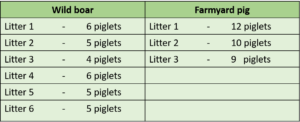Number (multiplication and division): Forest Piglets
Challenge level ⭐⭐
(designed for children with prior knowledge of the Year 3 and Year 4 programme of study)
Learning Objective
We are learning how to solve a natural world problem by using and applying our knowledge and skills of number, multiplication and division.
Useful prior knowledge:
- To recall multiplication and division facts for multiplication tables up to 12 × 12.
Credit: BBC Two - Springwatch
Clip Description
Pigs are thought to be the most intelligent of all the domesticated animals. Contrary to popular belief, they are very clean animals. Although they have poor eyesight, pigs have a great sense of smell. They use their long snouts to search for and root out food. Farmyard pigs have wild cousins called wild boar. These impressive mammals are widely distributed across the world.
In this fascinating clip, we can see a family of wild boar in their English woodland home. The family includes a litter of 5 piglets, who (after suckling on their mother’s milk for a few weeks) are ready to start sampling the delights of the forest floor. What do you think will be on the menu? Watch the clip to find out.
Quick Whiteboard Challenge
The number of litters and the number of piglets in each litter that a wild boar and a farmyard pig had in their lifetimes are shown in the table below.

Freya said, “The farmyard pig had fewer litters in her lifetime so must have had fewer piglets in her lifetime than the wild boar.”
Do you agree with Freya? Why or why not?

